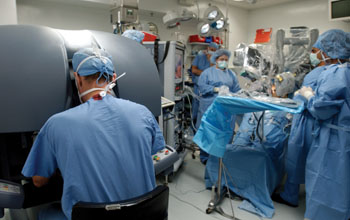
Dr. Michael Holzman, associate professor of Surgery, works from a console to operate on James Lewis during the first robotically-assisted esophageal surgery performed in Middle Tennessee. Dana Johnson
Robotically-assisted esophageal surgery pioneered at VUMC
Vanderbilt is now the only hospital in Tennessee offering a robotically-assisted surgery to treat severe cases of gastro-esophageal reflux disease (GERD). The first three Nissen Fundoplication procedures of this type to be performed in Middle Tennessee took place Tuesda.
The machine — called da Vinci — was created by Intuitive Surgical Inc. and replaces the surgeon’s hands, mimicking real motions. This allows for greater precision and movement in small areas during endoscopic procedures like the Nissen Fundoplication, said the company’s representative Matt Cavanaugh.
Associate professor of Surgery Dr. Michael Holzman, who performed Tuesday’s operations, first operated on patient James Lewis, a Channel 4 reporter. Working at a console, Holzman could look through two three-chip video cameras. The cameras provided 10 times the normal rate of magnification and 3-D views instead of the typical two-dimensional views from monitors used in typical endoscopic procedures.
“Vanderbilt continues to strive to be on the cutting edge of medical care for its patients,” Holzman said. ”This robotic procedure fits with that mission.”
GERD causes regurgitation of gastric contents back into the esophagus in pathological proportions, Holzman said.
Lewis opted for the surgery because other treatments for GERD failed. After the surgery, it could take up to one month of recovery time before he can begin eating a regular diet.
“To me, the trade off is worth it — I’m just glad this procedure is available,” said Lewis.
In addition to the esophageal surgery, Cavanaugh said da Vinci has already been used at Vanderbilt for approximately 50 prostate procedures and will soon be used in cardiac and pediatric operations here.
“This instrument is still in evolution and hopefully will open new frontiers for minimally-invasive surgeries such as traditional operations done laparoscopically,” said Holzman.













